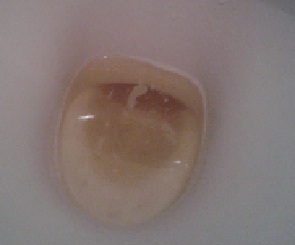Necessary Action

Description
The fluid resulting from purifying blood within the kidneys. Urine consists of 95% water and 5% solids. Urine is virtually sterile and nearly odourless (although smell can change due to various causes.) The pH of urine can vary between 4.6 and 8, with 7 (neutral) being norm.
Function
Elimination of liquid, and soluble waste that require elimination from the bloodstream. On average the human bladder can hold 13 ounces of liquid, and an average production in adult humans being 1–2 Litres per day. Urea is toxic and can be irritating to skin and eyes. Buddhist Monks are advised to use fermented cows urine for medicine.
Colour
In healthy persons the colour is amber, clear or pale yellow although there are other colours resulting from diet, disease, or other condition.
The fluid resulting from purifying blood within the kidneys. Urine consists of 95% water and 5% solids. Urine is virtually sterile and nearly odourless (although smell can change due to various causes.) The pH of urine can vary between 4.6 and 8, with 7 (neutral) being norm.
Function
Elimination of liquid, and soluble waste that require elimination from the bloodstream. On average the human bladder can hold 13 ounces of liquid, and an average production in adult humans being 1–2 Litres per day. Urea is toxic and can be irritating to skin and eyes. Buddhist Monks are advised to use fermented cows urine for medicine.
Colour
In healthy persons the colour is amber, clear or pale yellow although there are other colours resulting from diet, disease, or other condition.
- Dark yellow urine is often indicative of dehydration.
- Yellowing/light orange may be caused by removal of excess B vitamins from the bloodstream. Certain medications can cause orange urine.
- Bloody urine is termed hematuria, a symptom of a wide variety of medical conditions
- Dark orange to brown urine can be a symptom of certain diseases.
- Black or dark-coloured urine is referred to as melanuria and may be caused by a melanoma.
- Pinkish urine can result from the consumption of beets.
- Greenish urine can result from the consumption of asparagus.
- Reddish or brown urine may be caused by porphyria
- Blue - RARE: Artificial colors in foods or drugs; bilirubin; medications such as methylene blue; unusual Urinary Tract Infections.
- White/colourless - Most caused by excessive hydration.
- Foaming/fizzy - If occasional, a harmless hydraulic effect. This could indicate excess protein in the diet or a kidney problem.
Shape
Watery liquid.
Location
The urinary system. Urine is formed in the kidneys, passed through to the urinary bladder via the ureters where it is stored and expelled through the urethra.
Watery liquid.
Location
The urinary system. Urine is formed in the kidneys, passed through to the urinary bladder via the ureters where it is stored and expelled through the urethra.
 RSS Feed
RSS Feed
